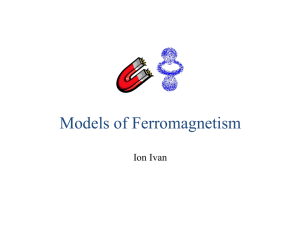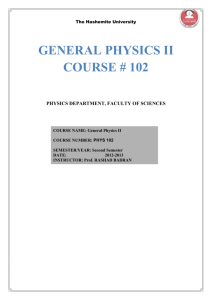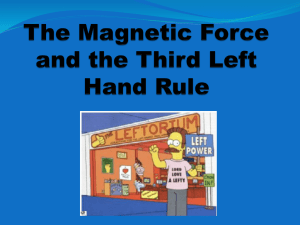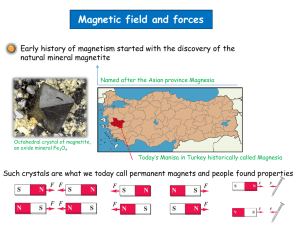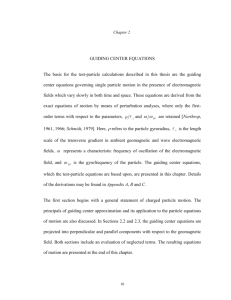Single particle motion
advertisement
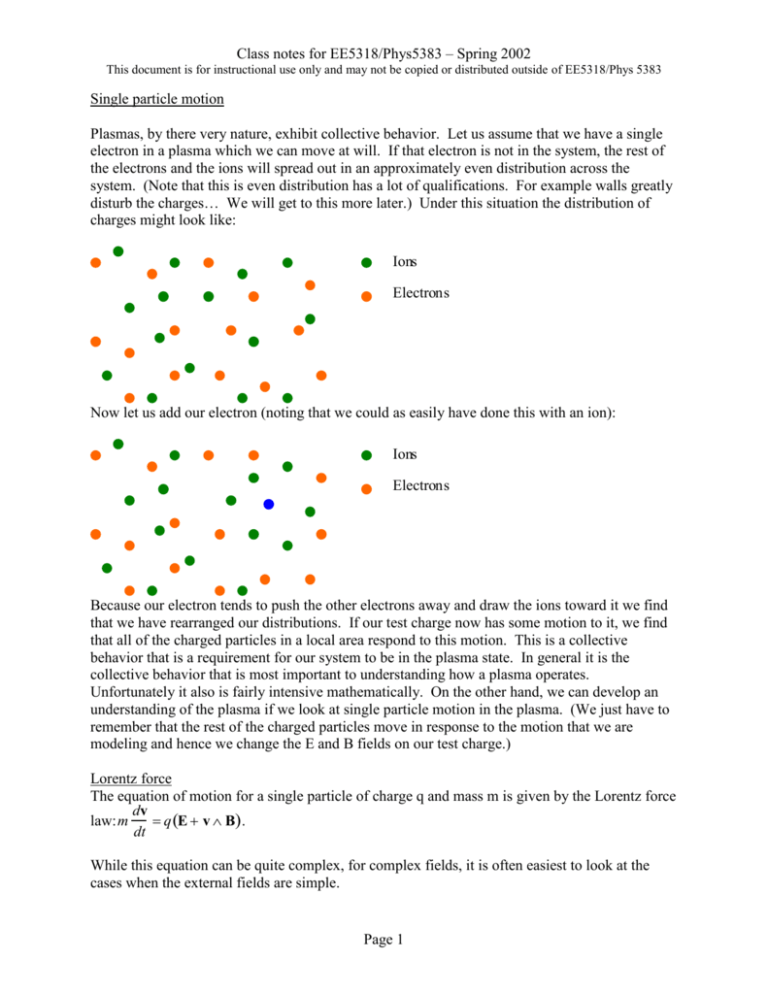
Class notes for EE5318/Phys5383 – Spring 2002 This document is for instructional use only and may not be copied or distributed outside of EE5318/Phys 5383 Single particle motion Plasmas, by there very nature, exhibit collective behavior. Let us assume that we have a single electron in a plasma which we can move at will. If that electron is not in the system, the rest of the electrons and the ions will spread out in an approximately even distribution across the system. (Note that this is even distribution has a lot of qualifications. For example walls greatly disturb the charges… We will get to this more later.) Under this situation the distribution of charges might look like: Ions Electrons Now let us add our electron (noting that we could as easily have done this with an ion): Ions Electrons Because our electron tends to push the other electrons away and draw the ions toward it we find that we have rearranged our distributions. If our test charge now has some motion to it, we find that all of the charged particles in a local area respond to this motion. This is a collective behavior that is a requirement for our system to be in the plasma state. In general it is the collective behavior that is most important to understanding how a plasma operates. Unfortunately it also is fairly intensive mathematically. On the other hand, we can develop an understanding of the plasma if we look at single particle motion in the plasma. (We just have to remember that the rest of the charged particles move in response to the motion that we are modeling and hence we change the E and B fields on our test charge.) Lorentz force The equation of motion for a single particle of charge q and mass m is given by the Lorentz force dv q E v B . law: m dt While this equation can be quite complex, for complex fields, it is often easiest to look at the cases when the external fields are simple. Page 1 Class notes for EE5318/Phys5383 – Spring 2002 This document is for instructional use only and may not be copied or distributed outside of EE5318/Phys 5383 Case 1: E Ezzˆ; B 0 dv q E v B dt m q Ezzˆ m Integrating gives x x0 vx 0 t Letting E E 0 ; B 0 q 2 Gives r = r0 v0 Et 2m 0 y y0 v y 0 t q E t2 2m z This is quite simple and not terribly informative. This would imply that the charged particle accelerates to infinite velocities. In real systems the electric field does not extend to infinity and collisions tend to slow the particle down. (Run away charged particles do occur – eventually running into walls – resulting in the production of Deep UV and x-ray production in some plasma systems.) z z0 vz0 t Cases 2: E 0; B B0 zˆ dv q E v B dt m q v B0 ˆz m Thus we find dv x q v y B0 dt m dvy q vx B0 dt m dvz 0 dt To solve this set of equations, we must separate the components of the velocity. This is simple to do by differentiating the equations again and substituting to give. d 2 v x q dvy q 2 B B v m 0 x dt 2 m dt 0 d 2 vy 2 2 q dvx q B0 B0 vy m dt m dt d 2 vz 0 dt 2 These second order equations are of course are easily solved as Page 2 Class notes for EE5318/Phys5383 – Spring 2002 This document is for instructional use only and may not be copied or distributed outside of EE5318/Phys 5383 v x v x0 e ic t v y v y0 e i c t where c q B m 0 vz vz 0 Now taking into account the original coupled first order equations we find v x v 0 cos c t v y v 0 sin c t v z v z0 Integrating a second time we find, v v x 0 sin c t x 0 0 sin c y v 0 c c cos ct y0 v 0 c cos z vz 0 t z0 v rc 0 c It is easy to see that rc v 0 is the radius of a circular orbit around the magnetic field line; it is c known as the Larmor radius or the cyclotron radius. Further we note that the positively charged particles orbit in a left-hand orbit while the negatively charged particles orbit in a right-hand orbit. Example Of particular interest is the magnetic field required to give an electron a gyro-frequency of 2.45 GHz. This is of interest because it is required to understand Electron Cyclotron Resonance, ECR, plasma sources. (Given time at the end of the semester, we will discuss these sources in detail.) fc c 2 q B0 2m 2.8E6 B0 (Hz / Gauss ) B0 875G Case 3: E E zzˆ; B B0 ˆz Page 3 Class notes for EE5318/Phys5383 – Spring 2002 This document is for instructional use only and may not be copied or distributed outside of EE5318/Phys 5383 dv q E v B dt m q Ezzˆ m xˆ vx yˆ vy 0 0 zˆ v z B0 or dv x q v y B0 dt m dvy q vx B0 dt m dvz q Ez dt m This is easy to solve as we have already done this as parts. x rc sin ct x0 rc sin y rc cos ct y 0 rc cos z z0 vz 0 t rc q 2 Ez t 2m v 0 c Case 4: E E x xˆ ; B B0 zˆ: Note that E Ey yˆ would also work here dv q E v B dt m xˆ yˆ zˆ q Ex xˆ v x vy vz or m 0 0 B0 dvx q E c vy ? dt m x dv y c v x ? dt dvz 0 vz vz 0 ; z v zt z0 dt The third equation is easy to solve while the first two are more difficult. Differentiating gives Page 4 Class notes for EE5318/Phys5383 – Spring 2002 This document is for instructional use only and may not be copied or distributed outside of EE5318/Phys 5383 d 2v x c2 v x 2 dt v x vx 0 e i c t 2 d vy q 2 c E x cv y dt m qB E c 0 x c vy m B0 E d v y d 2 Ex x vy but so 2 2 vy B0 dt dt B0 2 2 c vy Ex i t vy 0 e c B0 Ex B0 Plugging these into our initial equations gives i t E dv x q Ex c v y0 e c x dt m B0 v y vy 0 e i c t c v y0 e ic t i cv x 0 e ic t v y 0 iv x 0 Let v iv y 0 v x 0 giving v x ve i c t v cos ct Ex E v sin c t x B0 B0 v z v z0 ; z vzt z0 This means that the particle travels along the as it would with just the magnetic field but it also have a drift in the E B direction. We can calculate this in general. First the average force is F qE v B 0 Therefore v y iv e ic t Page 5 Class notes for EE5318/Phys5383 – Spring 2002 This document is for instructional use only and may not be copied or distributed outside of EE5318/Phys 5383 F B qE B v B B 0 E B v B B B v B v B• B B v • B Now if there is no drift along B then we get E B v B2 What we have described above is true in general. Assuming that we have any constant force that is a right angle to the magnetic field. Ftotal B 0 F B qv B B v drift F B qB 2 Case 5: E 0; B B0 r • B ... : Non - uniform magnetic field Here we look at a magnetic field that is non-uniform in space. The Taylor series expansion of such a field will be of the form B B0 r • B ... This should be straight forward from Bzy Bz0 y y Bz ... Now from Lorentz’s Force Law we have dv m q E v B qv B dt or in the y-direction dv m y qv x Bz dt qv x Bz0 yy Bz ... (We can do the same thing in the x-direction.) The force averaged over one gyration is dv y m q v x Bz0 yv x y Bz ... dt The first term is clearly zero. The second term is not as Page 6 Class notes for EE5318/Phys5383 – Spring 2002 This document is for instructional use only and may not be copied or distributed outside of EE5318/Phys 5383 yv x rc cos ct y0 rc cos v 0 cos c t rc v 0 cos2 c t - all of the other terms are zero 1 rc v 0 2 We can now plug this into our average force equation to get dv y 1 m q rcv 0 y Bz or in general dt 2 1 q rcv 0 Bz 2 1 2 1 mv0 Bz 2 B In the x-direction this becomes dvx m q vy Bz0 yv y y Bz ... dt but = yv y rc cos ct y0 rc cos v 0 sin c t rc v 0 cos c t sin c t =0 Thus, we have from above a drift velocity F B v drift 2 qB 1 B Bz rcv 0 2 2 B 1 1 B Bz mv2 0 2 B B2 This leads into a topic known as magnetic mirrors. Magnetic mirrors are naturally occurring phenomena that happen at the magnetic poles of planets and stars. In laboratory-based plasmas magnetic mirror are used in some process systems to confine the plasma. (They were also used – quite unsuccessfully - as a confinement mechanism for fusion plasmas.) In a mirror the gradient of the magnetic field is parallel to the direction of the field lines. This sort of arrangement is known as a cusp field and looks like the figure below. (This is the geometry one finds with permanent magnets.) Page 7 Class notes for EE5318/Phys5383 – Spring 2002 This document is for instructional use only and may not be copied or distributed outside of EE5318/Phys 5383 z From Maxwell’s Equations we have •B 0 - in cylindrical coordinates r -1 r rBr z Bz 0 - or r r rBr z Bz Integrating over r and assuming z Bz is not a function r gives -1 rB dr r B dr r r z rBr z r2 B 2 z z r 0 r Br z Bz 2 r 0 Now from Lorentz, F qE v B 0 Fr qv Bz v z B qv Bz F qv z Br vr Bz 0 r Fz qvr B v Br qv Br qv z Bz 2 r0 Now Page 8 Class notes for EE5318/Phys5383 – Spring 2002 This document is for instructional use only and may not be copied or distributed outside of EE5318/Phys 5383 v v 2x v 2y v and v r rc c has to do with the direction of . where c q B m 0 Thus Fz qv q rc zBz 2 2 v z Bz 2 c 12 mv2 1 B B z z z Bz where 12 mv2 1 B is the magnetic moment of a particle gyrating around a point. This can be easily seen from IA - where I and A are the current and area q = c rc2 2 2 qv 2 c 1 2 mv2 B What does this mean? As a particle moves into a region of increasing B, the Larmor radius shrinks but the magnetic moment remains constant. (This is shown in a number of books, including Chen.) Since the B field strength is increasing the particles tangential velocity must increase to keep constant. The total energy of the particle must also remain constant and thus the particle velocity parallel to the magnetic field must decrease. This causes the particle to bounce off of the ‘magnetic mirror’. (There are still ways for some of the particles to ‘leak’ through the mirror. This is one of the major reasons that magnetic mirrors did not work in the fusion field.) Additional drift motions There are a number of additional drift motions that occur for single particles. We unfortunately do not have time to cover these drifts. The other drifts include: Curved B: Curvature drift Non-uniform E Curved Vacuum fields Polarization Drift. Most of these are covered in the main text or in Chen. Page 9

